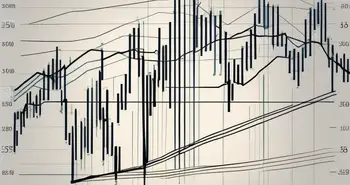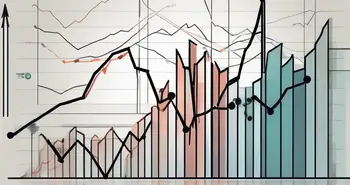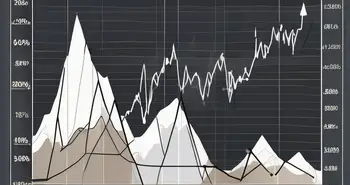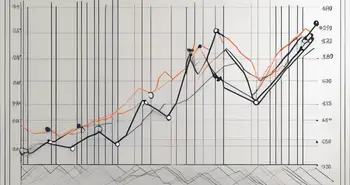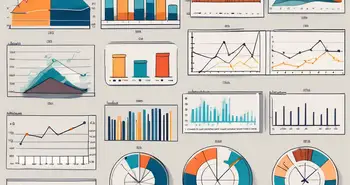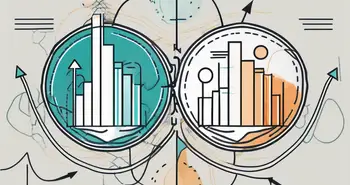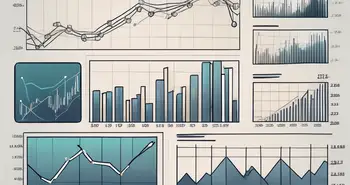Understanding Volatility Indicators: A Comprehensive Guide
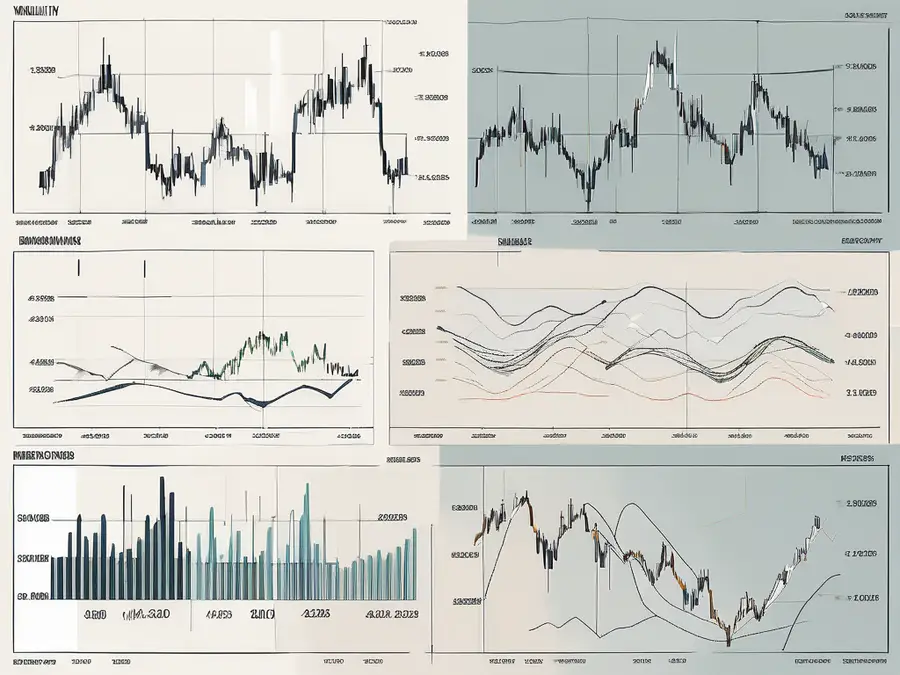
In the fast-paced world of financial markets, understanding volatility is crucial for successful trading. Volatility indicators provide valuable insights into market conditions and help traders make informed decisions. In this comprehensive guide, we will explore the concept of volatility, the different types of volatility indicators, how they work, their importance in trading, and debunk common misconceptions surrounding them. So let's dive in and unravel the mysteries of volatility indicators!
Defining Volatility in the Financial Market
Volatility refers to the degree of price fluctuations in a financial asset over a period of time. It measures the market's expectations of potential price changes and reflects market sentiment and uncertainty. Volatile markets experience rapid price swings, while less volatile markets tend to have relatively stable prices.
Understanding volatility is crucial for traders, as it affects every aspect of trading, from risk management to profit potential. Without a solid grasp of volatility, traders are essentially navigating blindfolded, risking their capital without a clear understanding of market dynamics.
Let's dive deeper into the role of volatility in trading and explore how it directly impacts profitability and risk management.
The Role of Volatility in Trading
Volatility plays a crucial role in trading as it directly impacts the profitability and risk management of a trade. Traders who understand volatility can make more informed decisions, increasing their chances of success in the market.
One way volatility influences trading is by helping traders determine appropriate entry and exit points. In highly volatile markets, traders may look for opportunities to enter trades during price swings, aiming to capture larger profits. Conversely, in low-volatility markets, traders may opt for more conservative entry points to minimize risk.
Another aspect affected by volatility is the setting of stop-loss orders. These orders are used to limit potential losses by automatically closing a trade if the price reaches a predetermined level. In highly volatile markets, traders might adjust their risk tolerance and widen their stop-loss levels to accommodate larger price fluctuations. On the other hand, in a low-volatility market, traders may tighten their stop-loss orders to protect against unexpected price reversals.
Moreover, volatility influences position sizing. Traders who understand the level of volatility in a market can adjust their position sizes accordingly. In highly volatile markets, smaller position sizes may be preferred to manage risk, while in low-volatility markets, larger positions may be taken to maximize potential profits.
Key Concepts Related to Market Volatility
Before delving into volatility indicators, it's essential to grasp a few key concepts related to market volatility. One such concept is historical volatility, which measures past price fluctuations and helps traders anticipate future price movements. By analyzing historical volatility, traders can gain insights into the potential range of price swings and adjust their trading strategies accordingly.
Another concept worth mentioning is implied volatility. Implied volatility reflects the market's expectations of future volatility. It is derived from options prices and provides traders with an indication of how much the market expects an asset's price to fluctuate in the future. Traders often use implied volatility as a gauge to assess market sentiment and make trading decisions.
As an expert in the field, let me share a personal story that highlights the importance of understanding volatility indicators. I once witnessed a sudden spike in implied volatility before a major economic announcement. While many traders panicked, I remained calm and used volatility indicators to make informed trading decisions. This allowed me to seize opportunities and avoid potential pitfalls during this volatile period.
In conclusion, volatility is a fundamental concept in the financial market that traders must comprehend to navigate the ever-changing landscape. By understanding volatility's role in trading and familiarizing themselves with key concepts related to market volatility, traders can make more informed decisions, manage risk effectively, and increase their chances of success.
Types of Volatility Indicators
Volatility indicators come in various forms, each offering unique insights into market conditions. Let's explore some of the most common types:
Overview of Historical Volatility
Historical volatility, also known as statistical volatility, calculates the standard deviation of an asset's price over a specific period. It helps traders assess the magnitude of past price movements and predict future volatility. Common historical volatility indicators include the Average True Range (ATR) and Bollinger Bands.
Understanding Implied Volatility
Implied volatility reflects the market's expectations of future price fluctuations. It is derived from options prices and indicates the perceived level of risk. Traders often use implied volatility indicators, such as the Volatility Index (VIX), to gauge market sentiment and make predictions about potential price movements.
Insights into Relative Volatility Index
The Relative Volatility Index (RVI) compares recent price changes to average price changes over a specific period. It provides insights into whether a market is overbought or oversold, helping traders identify potential reversal points. The RVI is a valuable tool in trend analysis and can be used in conjunction with other indicators to confirm trading signals.
How Volatility Indicators Work
Volatility indicators utilize complex mathematical formulas to calculate and interpret market volatility. Let's explore two key aspects:
The Mathematics Behind Volatility Indicators
Volatility indicators use statistical calculations to measure price deviations and standard deviations. These calculations help identify periods of high and low volatility and provide valuable insights into market dynamics. However, it's important to remember that no indicator is foolproof and should be used in conjunction with other technical analysis tools.
Interpreting Volatility Indicator Readings
When interpreting volatility indicator readings, traders must consider various factors, including the time frame, market conditions, and the asset being traded. A high reading may suggest increased market uncertainty and potential trading opportunities, while a low reading may indicate a period of consolidation or limited trading opportunities.
Importance of Volatility Indicators in Trading
Volatility indicators are invaluable tools for traders seeking to optimize their trading strategies and manage risk effectively. Let's explore two key aspects:
Risk Management and Volatility Indicators
Proper risk management is essential in trading, and volatility indicators play a crucial role in this aspect. By understanding the level of volatility in the market, traders can adjust their risk tolerance, position sizes, and stop-loss levels accordingly. This helps protect capital and manage potential losses.
Volatility Indicators and Trading Strategies
Volatility indicators provide valuable insights into market conditions and can be used to fine-tune trading strategies. For example, some traders use volatility breakouts to identify potential trade entries, while others may utilize volatility squeeze patterns to anticipate significant price movements. The key is to choose indicators that align with your trading style and objectives.
Common Misconceptions About Volatility Indicators
Despite their usefulness, volatility indicators are often misunderstood. Let's debunk some common misconceptions:
Debunking Myths Around Volatility Indicators
One common myth is that volatility indicators can predict market direction with certainty. While they provide insights into market conditions, they do not guarantee future price movements. Volatility indicators should be used as part of a comprehensive trading strategy, considering multiple factors.
Common Pitfalls in Using Volatility Indicators
Another trap that traders fall into is relying solely on volatility indicators and neglecting other important aspects of technical analysis. It's crucial to consider price patterns, support and resistance levels, and other indicators to confirm signals provided by volatility indicators. A holistic approach to trading is key to success.
FAQ: Frequently Asked Questions
What is the significance of volatility in trading?
Volatility directly affects the profitability and risk management of trades. Traders use volatility to determine entry and exit points, adjust risk tolerance, and manage position sizes.
Which volatility indicators should I use?
The choice of volatility indicators depends on your trading style and objectives. Historical volatility indicators like ATR and Bollinger Bands are popular, while implied volatility indicators like the VIX provide insights into market sentiment.
Can volatility indicators predict market direction?
No, volatility indicators cannot predict market direction with certainty. They provide insights into market conditions, but other factors such as price patterns and support/resistance levels must be considered when making trading decisions.
How can I avoid common pitfalls when using volatility indicators?
To avoid common pitfalls, use volatility indicators as part of a comprehensive trading strategy. Consider other technical analysis tools, confirm signals from volatility indicators, and never rely solely on one indicator for trading decisions.
With this comprehensive guide, you now have a solid understanding of volatility indicators and their significance in trading. Remember, successful trading is a combination of knowledge, experience, and the ability to adapt to changing market conditions. So go out there and make informed trading decisions using volatility indicators as one of your key tools!
Now that you're equipped with the knowledge of volatility indicators and their crucial role in trading, take your trading to the next level with Morpher. Experience the revolutionary trading platform that leverages blockchain technology to offer zero fees, infinite liquidity, and a unique trading experience across a multitude of asset classes. Whether you're looking to trade stocks, cryptocurrencies, or even the most unconventional markets, Morpher provides the tools for fractional investing, short selling, and up to 10x leverage. Embrace safety and control with the Morpher Wallet and start trading on a platform that's as innovative as your strategies. Sign Up and Get Your Free Sign Up Bonus today, and join the community of traders who are reshaping the future of investing.

Disclaimer: All investments involve risk, and the past performance of a security, industry, sector, market, financial product, trading strategy, or individual’s trading does not guarantee future results or returns. Investors are fully responsible for any investment decisions they make. Such decisions should be based solely on an evaluation of their financial circumstances, investment objectives, risk tolerance, and liquidity needs. This post does not constitute investment advice.

Painless trading for everyone
Hundreds of markets all in one place - Apple, Bitcoin, Gold, Watches, NFTs, Sneakers and so much more.

Painless trading for everyone
Hundreds of markets all in one place - Apple, Bitcoin, Gold, Watches, NFTs, Sneakers and so much more.

